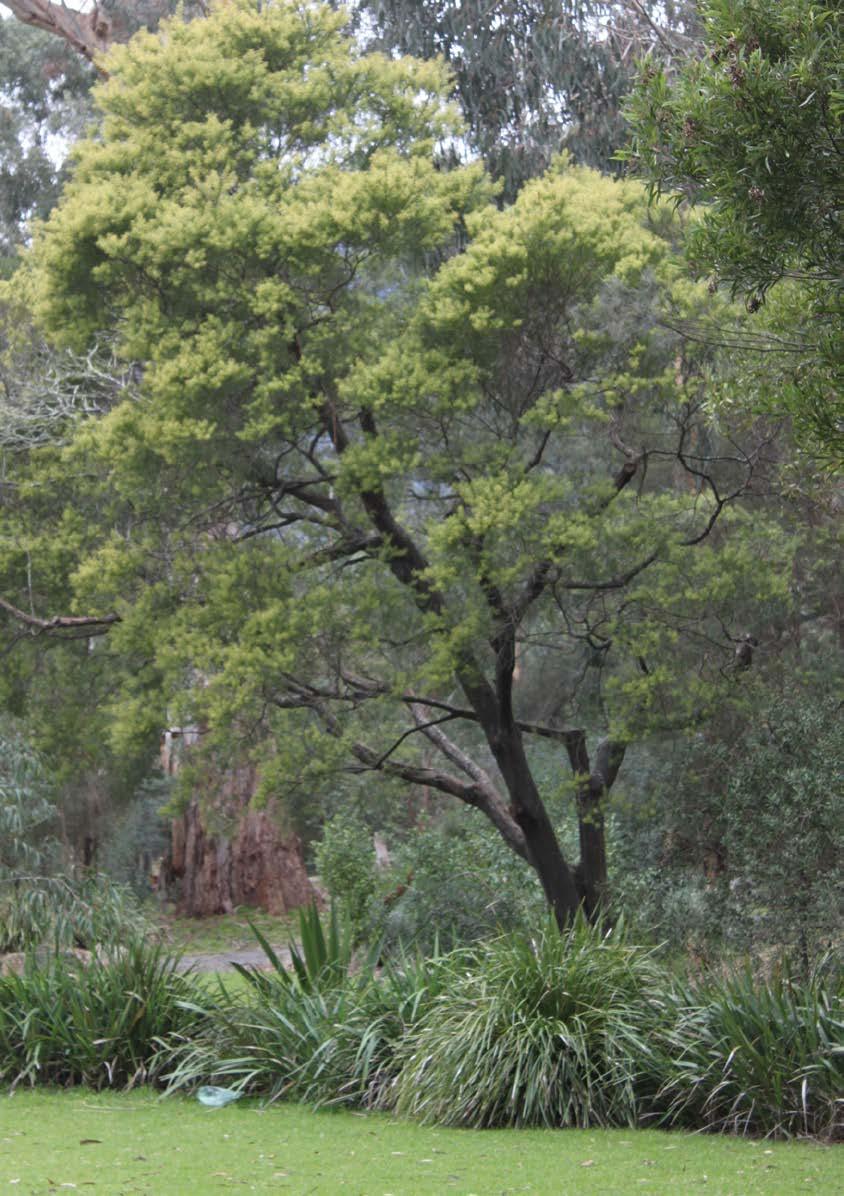
19 minute read
Native plants for your garden
The following is a selection of reliable native plants that will grow well in this region. The list includes some local native species - ‘Local Favourites’ - that work well in gardens.
If you are keen to attract wildlife to your garden the following icons indicate plants that will attract different wildlife:
Advertisement
Small birds such as wrens, robins and fantails
Nectar feeders such as spinebills, wattlebirds and honeyeaters
Parrots such as rosellas, galahs and cockatoos
Pollinators such as native bees and butterflies
Frogs such as the Eastern Banjo and Spotted Marsh Frog
Lizards such as the Marbled Gecko and Blue-tongue Lizard
Mammals such as microbats, gliders and possums
Large birds such as owls, Tawny Frogmouth and kookaburras
Please note: All plant sizes mentioned in this publication are approximate. Environmental conditions will influence the final height and width of a plant. -37-
Trees
Trees provide excellent shade and shelter. They contribute to the maintenance of biodiversity through the provision of wildlife corridors and habitat.
Silver Wattle (Acacia dealbata)
Kurrajong (Brachychiton populneus) (HF)
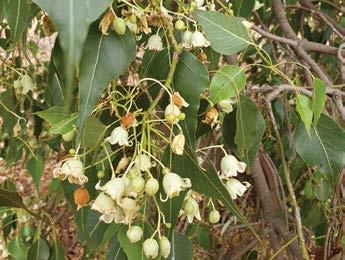
Brachychiton species
Flame Tree and Kurrajong
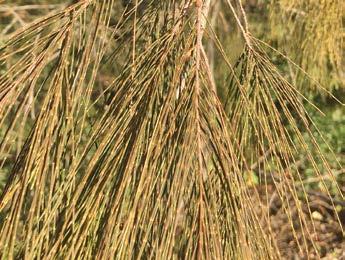
Allocasuarina torulosa
Rose or Forest She-oak
Fantastic feature or shade trees with slightly swollen trunks, striking flowers and glossygreen leaves.
Garden favourites
• Illawarra Flame Tree (Brachychiton acerifolius)
Local favourites
• Kurrajong (Brachychiton populneus)
Size and habit
• Medium to large trees 10 to 20m high. • Grafted dwarf varieties are becoming more available.
Flowers and foliage
Very attractive pink to red bell-shaped flowers. Seed pods contain fine hairs that can • Flowers on male plants are reddish brown
cause irritation. Will shed leaves in late spring/summer.
Preferred growing conditions
• Drought and frost tolerant. • Ensure these are planted at least 4m A tall, spreading evergreen tree with attractive drooping needle-like leaves that turn rusty-red when in flower in winter.
Size and habit
• Medium to large trees 10 to 20m high. • Grafted dwarf varieties are becoming more available.
Flowers and foliage
• Weeping, needle-like leaves. from any structure or path.
on the ends of branches, while female flowers are red along the stems. • Attractive hard seed cones.
Preferred growing conditions
• Full sun. • Tolerant of dry conditions. • Grows well in a wide range of well-drained soils.
Hymenosporum flavum
Native Frangipani
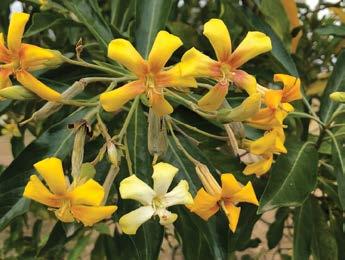
Silver Princess (Eucalyptus caesia)

Eucalyptus, Angophora and Corymbia species | Small Gum Trees
A small rainforest tree that grows surprisingly well in inland areas. Delightfully fragrant flowers!
Size and habit
• Grows to 8m high and 3-7m wide. • Small, slender tree. • Branches radiate in whorls from the main stem. • Rough grey bark.
Flowers and foliage
• Clusters of fragrant flowers during spring into early summer. • Young flowers are cream in colour aging to yellow. • Glossy green leaves to 10cm long.
Preferred growing conditions
• Sun to part-shade. • Tolerates a wide range of well-drained soils. • Benefits for high organic matter in the soil. • Protect from frost until the tree is a couple of metres tall. • Will require additional water during hot, dry weather. Compact trees with showy flowers. Advances in grafting and cultivation mean there are small gum trees suitable for almost any garden. Alternatively, look for ‘Mallee’ eucalypts that are naturally smaller with multiple trunks.
Garden favorites
• Grafted Flowering Gum (Corymbia ficifolia) • Silver Princess (Eucalyptus caesia) • Yellow Gum ‘Euky Dwarf’ (Eucalyptus leucoxylon) • Dwarf Apple (Angophora hispida)
Size and habit
• Many nurseries will stock grafted ‘dwarf’ varieties from 3 to 10m tall.
Flowers and foliage
• Flowers are typically oranges, reds, pinks, cream and yellows. • Leaves range in colour and length.
Preferred growing conditions
• Requirements will vary, so read labels carefully. • Small trees are still large plants, plant well clear of pipes, structures and other plants that need full sun.
Shrubs
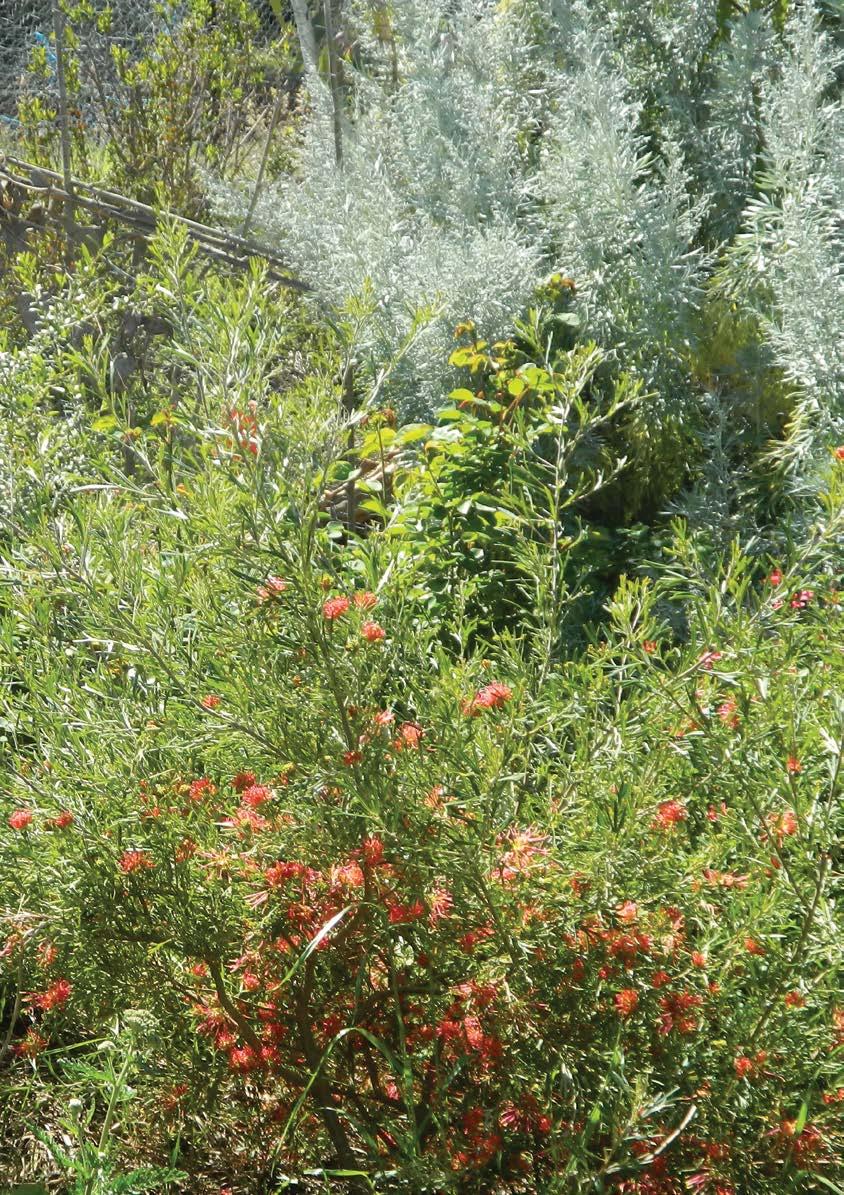
Ideal shelter or feature plants, shrubs provide colour, texture and layers within the garden. They also provide habitat and food, particularly for a variety of birds and butterflies.
(JO)
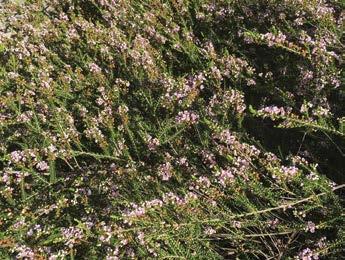
Thryptomene saxicola
Thryptomene FC Payne
Rosemary Grevillea (Grevillea rosmarinifolia)
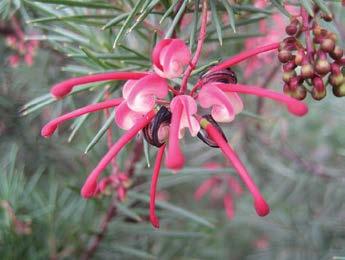
Grevillea species
Grevilleas
An attractive, tough shrub that keeps on One of the most popular and widely flowering and flowering! A feature plant cultivated of all Australian plants. They are in the garden, a small hedge or a great hardy and prolific flowerers. container plant. Fast-growing, versatile and hardy. Garden favourites • Robyn Gordon varieties Size and habit • Grows to 1.5m high and wide. • Low-growing, dense shrub with • • Rosemary Grevillea (Grevillea rosmarinifolia) Silky Grevillea (Grevillea sericea) weeping habit. Local favourites • It can be pruned by cutting off branches • Cat’s Claw (Grevillea alpina) to use as cut flowers, otherwise give it a • Woolly Grevillea (Grevillea lanigera) light trim coming out of winter. Size and habit Flowers and foliage • Most are small to medium shrubs. • Small, open-petalled, clusters of • Be sure to check the label. • • light-pink flowers from winter through spring. Oval-shaped leaves growing to 1cm. Foliage is spicy fragrant when crushed. Flowers and foliage • Masses of long-lived flowers ranging in size and colour. • Leaves range in size and shape and can Preferred growing conditions cause mild skin irritation. • Full sun or part-shade. Preferred growing conditions • Well-drained soil. • A sunny position with free-draining soil. • Tolerates mild frosts. • Drought-tolerant once established, but benefit from occasional deep-watering. • Tip prune for bushier growth and more flowers. • Frost tolerant. -42-
Weeping Bottlebrush (Callistemon viminalis)
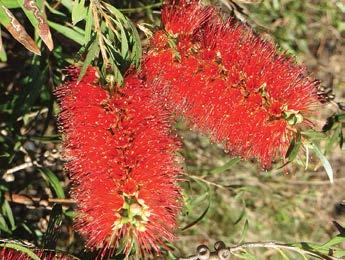
Callistemon species
Bottlebrushes
Tar Bush (Eremophila glabra)
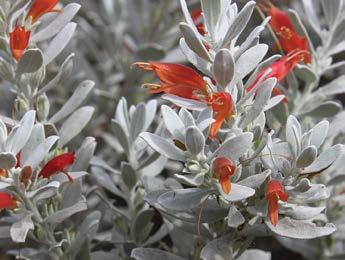
Eremophila species
Emu Bushes
An attractive, versatile and hardy addition to The beauty and abundance of their flowers, any garden. variety of foliage and habit, and extended Garden favourites • Weeping Bottlebrush flowering period make Emu Bushes excellent garden plants. (Callistemon viminalis) Garden favourites • Lemon Scented Bottlebrush • Showy Emu Bush (Eremophila nivea) (Callistemon citrinus) • Bignonia Emu Bush Local favourites • River Bottlebrush (Callistemon sieberi) • • (Eremophila bignoniiflora) Tar Bush (Eremophila glabra) Eremophila ‘Summertime Blue’ Size and habit • Woody shrubs ranging from 0.5 to 4m tall. • Respond well to heavy pruning. Size and habit • Usually small to medium shrubs 1 to 3m. • Larger shrubs and low-growing forms are also available. Flowers and foliage • Distinctive long-lived ‘bottlebrush’ flowers form in spring. • A range of colours. • New leaves can be very ornamental. Flowers and foliage • Beautiful tubular flowers in a range of colours. • Many have greyish, hairy foliage as protection against drying winds. Preferred growing conditions • A sunny position will produce the most flowers, but will tolerate anything but total shade. • Enjoys occasional watering once established, but can withstand drought. • Prune annually just behind spent flowers. Preferred growing conditions • Perform best in well-drained soils and rarely succeed in wet soils. • Be careful not to overwater. • Drought resistant and tolerate frost. • Can be pruned back by about one third after flowering to promote a bushy habit. -43-
Prickly Tea-tree (Leptospermum continentale)
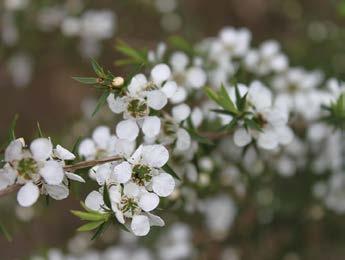
Leptospermum & Melaleuca species
Tea-trees and Paperbarks
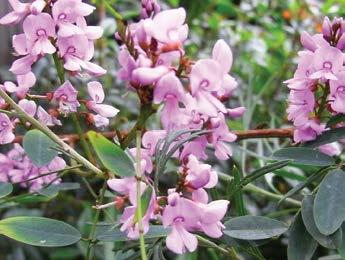
Indigofera australis
Austral Indigo
These desirable garden plants are hardy, versatile, have abundant, large, showy flowers and attractive foliage and bark.
Garden favourites
• Pink Tea-tree (Leptospermum squarrosum) • Violet Honey Myrtle (Melaleuca wilsonii) • Grey Honey Myrtle (Melaleuca incana) • Showy Honey Myrtle (Melaleuca nesophila)
Local favourites
• Prickly Tea-tree (Leptospermum continentale)
Size and habit
• Range from small to large shrubs. • Compact growth.
Flowers and foliage
• Flowers range from white to pink to red. • Small leaves, sometimes scented, often with red/purple new growth. • Regular tip pruning will prevent woody appearance.
Preferred growing conditions
• Full sun is preferred. • Will tolerate poor drainage. The Austral Indigo is a local favourite and member of the Pea family and produces branches of beautiful mauve and pink pea flowers.
Size and habit
• A graceful, open shrub. • Useful for understorey planting. • Benefits from pruning after flowering to maintain bushiness. • Grows to a height of 1-2m and a width of 1m.
Flowers and foliage
• Blue-green feathery leaves. • Abundant sprays of mauve to pink flowers from September to November.
Preferred growing conditions
• Any well-drained soil. • Water regularly during dry periods. • Grows in full sun to shade.
Coastal Westringia (Westringia fruticosa)
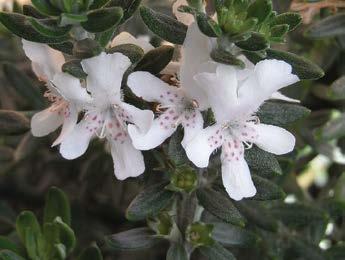
Westringia species
Westringias
Chef’s Cap Correa (Correa baeuerienii)
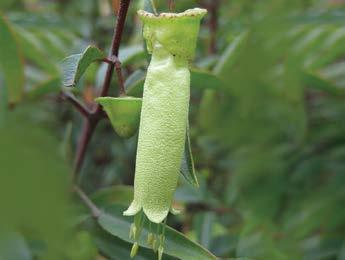
Correa species
Correas
With fine, dense grey-green foliage that responds well to pruning, Westringia’s are particularly useful for hedges, screening or topiary. They are also attractive unpruned in a low maintenance garden. These fastgrowing plants are ideal for filling gaps or kick starting an empty garden.
Garden favourites
• Westringia Wynyabbie Gem • Coastal Westringia (Westringia fruticosa)
Size and habit
• Available from 0.5 to 2m. • Dense compact shrubs.
Flowers and foliage
• Foliage is dense grey or green.
Prolific delicate mauve, blue or white flowers.
Preferred growing conditions
• Generally like full sun and good drainage but are adaptable to most conditions. These pretty, small to medium shrubs are a low maintenance and reliable native favourite. They are available in a variety of shapes and colours. Smaller varieties are useful for pots, courtyards or along path edges.
Garden favourites
• Chef’s Cap Correa (Correa baeuerlenii) • Rock Correa (Correa glabra)
Local favourites
• Native Fuchsia (Correa reflexa) • Mountain Correa (Correa lawrenceana)
Size and habit
• Compact shrubs with dense foliage up to 2m.
Flowers and foliage • Attractive drooping, bell-shaped flowers range from green, yellow to red.
Preferred growing conditions
• Full sun. • Frost hardy. • They have shallow roots so will survive beneath large trees. • Mulch to keep moist but avoid over watering.
(TW)
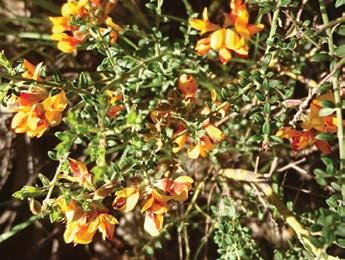
Mirbelia oxylobioides Mountain Bush-pea
Gold-dust Wattle (Acacia acinacea)

Acacia species
Wattles
A very attractive feature shrub for the garden or a low-level cover in windbreaks.
Size and habit
• Grows to 1.5m high and 1m wide. • Erect, spreading shrub in the pea family. • Prune to encourage compact shape.
Flowers and foliage
• Pea flowers are orange-yellow with reddish centre. • Flower from spring to summer. • Stems are covered in downy hairs. • Leaves are pointed and ovate to 10mm long.
Preferred growing conditions
• Full sun to part-shade. • Well-drained soils. • Tolerates frost. One of Australia’s most iconic plants producing abundant yellow flowers. These fast-growing plants are ideal for filling gaps or kick starting an empty garden.
Garden favourites
• Golden Wattle (Acacia pycnantha) • Lime Lights (Acacia cognata) • Ovens Wattle (Acacia pravissima)
Local favourites
• Gold-dust Wattle (Acacia acinacea) • Box-leaf Wattle (Acacia buxifolia) • Showy Wattle (Acacia decora)
• Varnish Wattle (Acacia verniciflua)
Size and habit
• Range in size from 1 to 4m. • Be sure to check plant labels.
Flowers and foliage
• Foliage varies. • Different varieties flower at different times of the year; many will provide welcome winter blooms.
Preferred growing condition
• Check labels for hardy species. • Avoid adding phosphorus. • Does not like heavy pruning but regular light pruning will maintain shape. -46-
Grasses and grass-like plants
These plants have become increasingly popular in landscaping, adding form, colour and texture variations to the garden.

Spiny-headed Mat-rush (Lomandra longifolia)
(AB)

Austrostipa elegantissima
Feather Spear-grass
Wattle Mat-rush (Lomandra filiformis)

Lomandra species
Mat-rushes
This local is a graceful, ornamental grass that is particularly attractive when mass planted.
Size and habit
• Grows to 1m high. • Tussock-forming grass. • Responds well to pruning.
Flowers and foliage
• Feathery silvery-white flower heads that turn purple-grey with maturity. • Flowers from spring to summer. • Bronze seed heads with corkscrew twists.
Preferred growing conditions
• Full sun or part-shade. • All well-drained soils. • Grows well on dry, sandy soil. This very hardy group is useful for providing leafy texture, as a border or in harsh locations. The fibrous root system is good for soil or slope stabilisation.
Garden favourites
There are large varieties of cultivars available, many of which will grow well in your garden, including: • ‘Tanika’ Mat-rush • ‘Fine N Dandy’ Mat-rush
Local favourites
• Spiny-headed Mat-rush (Lomandra longifolia) • Many-flowered Mat-rush (Lomandra multiflora)
Size and habit
• Check labels for dimensions.
Flowers and foliage
• Flowers are generally insignificant, although some have grass-like flowers. • Foliage is strappy and ranging from bright green to grey.
Preferred growing conditions
• Extremely hardy, will tolerate sun, shade, wet and dry conditions.
Blue Flax-lily (Dianella revoluta)
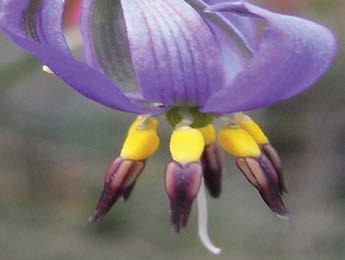
Dianella species
Flax-lilies
Bulbine Lily (Bulbine bulbosa) (SB)

Bulbine, Dichopogon and Arthropodium species | Small Lilies
Tough and low maintenance. Useful for borders, in pots or suppressing weeds over a larger area.
Garden favourites
There are large varieties of cultivars available, many of which will grow well in your garden, including: • ‘Little Devil’ Native Flax (Dianella tasmanica) • Utopia Native Flax (Dianella prunina) • ‘Little Rev’ Native Flax (Dianella revoluta)
Local favourites
• Blue Flax-lily (Dianella revoluta)
Size and habit
• 0.3 to 1m high. • ‘Running’ roots will naturally spread to fill an area.
Flowers and foliage
• Strappy, leathery leaves range from dark to blue green.
Blue-purple flowers usually followed by attractive blue berries. Small perennial pops of colour, great for rockeries, flower gardens and containers. Lovely when planted in large clumps.
Local favourites
• Bulbine Lily (Bulbine bulbosa) • Pale Vanilla Lily (Arthropodium milleflorum) • Chocolate Lilly (Dichopogon strictus)
Size and habit
• 0.3 to 0.8m high. • Dormant in dry times, will re-sprout from underground tubers.
Flowers and foliage
• Fine grass-like leaves with many small flowers clustered on long stems. • Range of colours.
Preferred growing conditions
• Will suit containers or shallow soils. • Keep moist to extend growing season. • Mark or label their position in garden so they are not damaged during dormancy.
Preferred growing conditions
• Will tolerate a range of conditions, but not permanent wet soil.
Kangaroo Paw ‘Pink Beauty’(Anigozanthos hybrid)
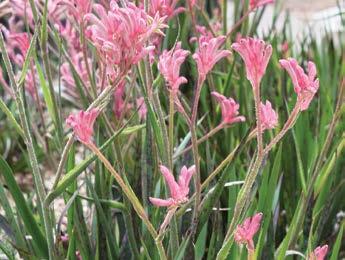
Anigozanthos species
Kangaroo Paws

Themeda triandra Kangaroo Grass
With distinctive, vibrant, fuzzy flowers and green strappy leaves, Kangaroo Paws are uniquely Australian. Best treated as a shortlived perennial providing colour and interest in the garden or in pots.
Garden favourites
There are many interesting varieties available, but the wild species Tall Kangaroo Paw (Anigozanthos flavidus) is the most reliable and long-lived.
Size and habit
• There are small and tall varieties up to 2m. • The smaller varieties are shorter lived.
Flowers and foliage
• Strappy green leaves with taller flowers that range that range in colour. • Flowering time late spring to mid-summer. This local is a great favourite feature tussock in the garden or mass planted.
Size and habit
• Tussock leaves grow to 40cm high and 80cm wide. • Stems grow above the plant to 70-90cm flowering from September to March.
Flowers and foliage
• Leaves vary in colour from blue-green to reddish-brown. • Lovely coppery, purple or rust-coloured flower heads on gently arching stems.
Preferred growing conditions
• Will tolerate most soils, but performs best in well-drained soils. • Grows in full or part-shade. • Grass tussocks can be cut back in early spring to encourage new green growth.
Preferred growing conditions
• Can be fussy, so take care to select the right variety for your garden. • Full sun and soil must be well-drained. • Remove spent flower heads and blackened leaves. • Suitable for pots, ensure they are well watered during growing season.
Low growing plants and climbers
These plants play an important role in the landscape. Not only are they attractive, they are useful for binding soil and minimising weed growth. They are also important for attracting pollinators, including butterflies, into your garden.

Baranduda garden
Cut-leaf Daisy (Brachyschome multifida)
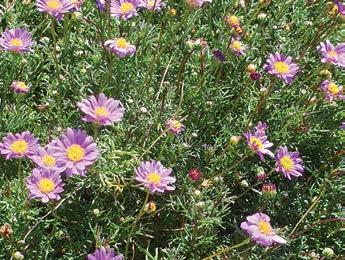
Brachyscome & Xerochrysum species | Daisies
(EL)

Pandorea pandorana
Wonga Vine
There is a large variety of native daisies that can bring colour to the garden in many ways: as mass plantings for dramatic colour, ground covers, edging plants or for splashes of colour amongst existing plants.
Garden favourites
• Billy Buttons (Craspedia globosa) • Native Daisy (Brachyscome species) • Everlasting or Paper daisies
Local favourites
• Sticky Everlasting (Xerochrysum viscosum) • Clustered Everlasting (Chrysocephalum semipapposum) • Hoary Sunray (Leucochrysum albicans)
Size and habit
• Low growing, generally 0.1 to 0.6m high. A variable native climber with twining branches. Tough, adaptable and attractive.
Size and habit
• A fast-growing plant. • Grows from 2-10m high and 1-9m wide. • Can be cut back hard after flowering to rejuvenate.
Flowers and foliage
• Masses of bell-shaped flowers in spring. • Flower colour variable from white, cream, yellow to gold with purple throat. • Glossy-green leaves.
Preferred growing conditions
• Full sun to part-shade. • Adaptable to most well-drained soils. • Tolerates light frost.
Flowers and foliage
• Generally flower in large numbers of yellows, pinks, whites and purple. • Foliage varies from green to grey.
Preferred growing conditions
• Will grow in pots or in the ground. • Full sun for best floral displays. • Remove spent flowers to avoid self seeding around your patch.
Myoporum parvifolium Creeping Boobialla

Grevillea Gaudi Chaudi (Grevillea gaudichaudii)
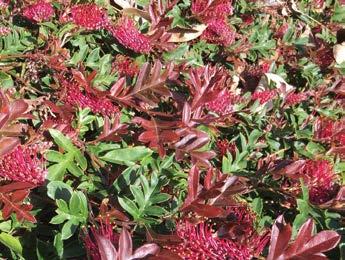
Grevillea species
Grevillea
A low maintenance groundcover that is great to deter weeds, cover slopes and banks and can be a lawn substitute for low traffic areas.
Size and habit
• Grows 20-30cm high and 1-3m wide. • Spreading form. • Fast-growing, prune to encourage annually after flowering to encourage new growth.
Flowers and foliage
• Masses of attractive white flowers. • Flowering time late spring to early autumn. • Dense, fine green leaves.
Preferred growing conditions
• Full sun to semi-shade. • Drought tolerant. • Tolerates light frost. Fantastic for slopes, as a ground cover and for landscaping large areas.
Garden favourites
• Mt Tamboritha Grevillea (Grevillea lanigera) • Grevillea Gaudi Chaudi (Grevillea gaudichaudii) • Grevillea Bronze Rambler • Poorinda Royal Mantle
Size and habit
• Generally 0.3 to 0.6m high. • Low growing varieties will vary in how far they spread, so check labels.
Flowers and foliage
• Flowers in shades of red, orange or yellow. • Evergreen foliage ranges from needle shaped to fern-like, some have bronze tips and some may cause mild skin irritation.
Preferred growing condition
• A sunny position with free-draining soil. • Drought tolerant once established, but will appear healthier with occasional deep watering. • Avoid fertilisers containing phosphorous.
Kennedia prostrata Running Postman
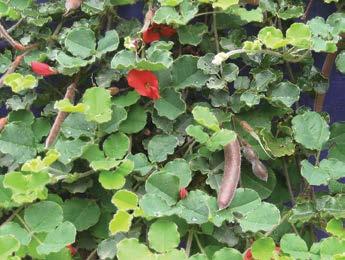
This local, trailing, hardy and adaptable groundcover grows well in rockeries or hanging baskets where flowers can cascade down the sides.
Size and habit
• Groundcover with long, slender trailing stems. • Generally spreads to 1-2m.
Flowers and foliage
• Attractive grey-green leaves with a soft texture and wavy edges. • Bright red, pea-shaped flowers with a yellow centre. Flowers from April to December. • Dark brown leathery pods to 7cm.
Preferred growing conditions
• Well-drained soil. • Full to part-shade. Hardenbergia violacea
Purple Coral Pea
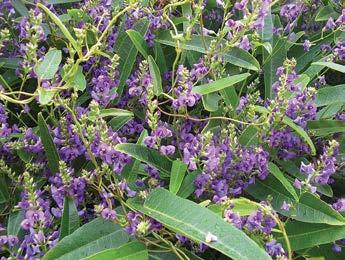
Very showy scrambler which will lightly twine over shrubs and on trellises or remain flat. A bush local, with many forms commercially available.
Size and habit
• A climbing plant whose woody branches twist around the stems of other plants. • Moderately vigorous, but rarely covers other plants so extensively as to cause damage. • For compact growth, prune after flowering.
Flowers and foliage
• Large sprays of pea flowers, massed along branches. • Purple flowers appear in winter and spring. • Dark, glossy-green leaves.
Preferred growing conditions
• Flowers best in full sun. • Adaptable to most soils. • Tolerates light frosts.
Glycine clandestina Twining Glycine
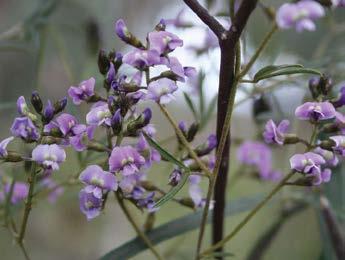
Light, open twining herb with long stems, often not noticed until it flowers. This local favourite is a gentle climber for a shady garden.
Size and habit
• Slender, light climber. • Hardy once established. • Grows from 30cm to 2m.
Flowers and foliage
• Loose sprays of attractive blue-mauve pea flowers. • Flowering from spring to summer. • Sparsely scattered small, dark-green leaves.
Preferred growing conditions
• Part-shade to shade. • Moist well-drained soils. • Tolerates dryness once established.
Ruby Saltbush (Enchylaena tomentosa)

Rhagodia, Einadia & Enchylaena species | Saltbushes
Small to medium plants that tend to spread out. Very hardy with attractive dense foliage and some have brightly coloured berries.
Garden favourites
• Spiny saltbush (Rhagodia spinescens) • Nodding saltbush (Einadia nutans) • Ruby saltbush (Enchylaena tomentosa)
Size and habit
• 0.4 to 1.5m in height, width will vary with species up to 4m.
Flowers and foliage
• Flowers are insignificant. • Foliage is fine and dense, often silver-grey.
Preferred growing conditions
• Full sun or part-shade. • Will cope with poor or saline soils, frost and drought.
Windbreaks and hedges
Many plants are responsive to pruning and can be shaped into a hedge or mass planted to form a windbreak.

Tea-tree (Leptospermum species)
Correa alba
White Correa

Victorian Christmas Bush (Prostanthera lasianthos) (RE)

Prostanthera species
Mint Bushes
A hardy shrub that responds well to pruning.
Size and habit
• A dense, spreading shrub that is moderately slow-growing. • Grows to 1-2m high and wide. • An excellent hedging plant.
Flowers and foliage
• Grey-green leaves, pale and hairy underneath. • Waxy, white star-shaped flowers most of the year.
Preferred growing conditions
• Grows in all well-drained soils. • Once established it will tolerate extended dry periods. An excellent shrub for moist, sheltered positions. Contact releases a minty fragrance.
Size and habit
• Grows 1-3m high and 2-3m wide. • Fast-growing, dense rounded shrub. • Pruning after flowering maintains bushiness and vigour.
Flowers and foliage
• Shrub with dark mauve, pink or white flowers. • Flowers from spring to summer. • Rounded, dark-green leaves with a strong minty aroma.
Preferred growing conditions
• Part-shade to full shade. • Moist well-drained soils.





